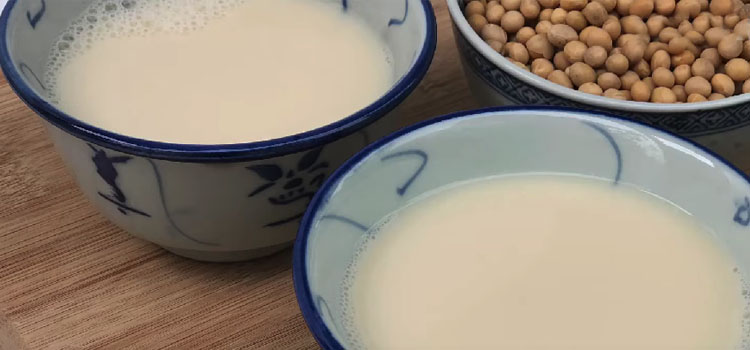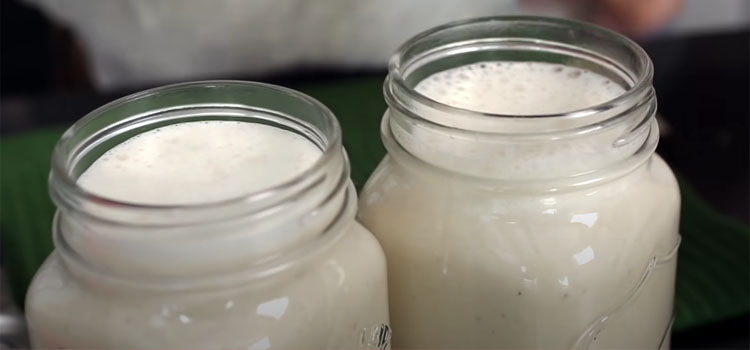Last Updated on September 15, 2024 by Shari Mason
Got a passion for soy milk? Ever thought about the **best way to store it**?
Here’s the big question: does soy milk need to be kept cool in the refrigerator, or is it okay to leave it out?
Let’s learn more about how to care for our soy milk.


Yes, soy milk [1] must be refrigerated once opened, much like its dairy counterparts and other plant-based milk.
This is because it can foster the growth of harmful bacteria if left at room temperature for an extended period.
“There’s no such thing as soy milk. It’s soy juice.”
– Lewis Black, American Comedian
Unopened soy milk, however, can remain unrefrigerated if it is of the UHT (Ultra High Temperature) variety which has been treated to kill bacteria and extend its shelf life.
It is always essential to read the storage instructions provided by the manufacturer on the packaging.
Can You Freeze Soy Milk?
You can freeze soy milk, but it’s important to note that the texture and taste might change once thawed.
The freezing process can cause the water content in the milk to form ice crystals, leading to a grainy texture and possible separation of components when thawed.
This may not be desirable for straight-up drinking, but it would still work for cooking or baking. So while freezing is an option, it is not the best for preserving the original qualities of soy milk.
Read:
- Substitute For Soy Paste
- How Long Does Natto Last In The Fridge?
- Can You Mix Oat Milk With Cows Milk?
Health Benefits Of Soy Milk
- Rich in Proteins: Soy milk contains a good amount of proteins which are vital for tissue repair and growth.
- Lactose-Free: It is an excellent option for lactose intolerant as it contains no lactose.
- Low in Fat: Soy milk is low in saturated fat, making it a healthier choice for those watching their cholesterol levels.
- Contains Essential Nutrients: It’s packed with essential nutrients, including potassium, calcium, and vitamins A, B12, and D.
- Heart-Healthy: It contains isoflavones believed to help lower harmful cholesterol levels, potentially reducing the risk of heart disease.
- Good for Bone Health: The calcium and vitamin D in fortified soy milk promote bone health and can help prevent osteoporosis.
- Antioxidant Properties: Soy milk contains antioxidants [2] that fight inflammation and prevent certain diseases.
How To Know If Soy Milk Is Bad?


- Change in Texture: Fresh soy milk has a smooth and liquid texture. If your soy milk becomes chunky or thicker, it’s a sign that it has spoiled.
- Sour Smell: Soy milk should have a mild, pleasant smell. It is likely past its prime if it gives off a sour or unpleasant odor.
- Change in Color: If your soy milk has turned from a creamy white to a yellowish hue, it is probably spoiled.
- Altered Taste: Spoiled soy milk will have a distinctly sour taste that differs from fresh soy milk.
- Mold Growth: Any sign of mold growth on the container or the liquid indicates that your soy milk has gone bad.
- Past Expiry Date: Although soy milk can last a few days past its expiration date if unopened and properly stored, it’s best not to consume it if it’s too far past this date.
“When it comes to soy milk, remember this adage: ‘Chill it to keep its thrill.’ Proper refrigeration is the secret to enjoying every sip of its healthy goodness.”
– Eat Pallet Restaurant & Food Advice
Tips On How To Store Soy Milk
- Refrigerate After Opening: Soy milk should continually be refrigerated to prevent spoilage.
- Seal Tightly: Ensure the carton or container is sealed tightly after every use to prevent the entry of bacteria.
- Use Within 7-10 Days: After opening, try to consume the soy milk within a week to 10 days. Even with refrigeration, it won’t last indefinitely.
- Store Away from Light: Soy milk should be kept in a cool, dark place to preserve its nutritional content and flavor.
- Don’t Leave at Room Temperature: Never leave an open carton of soy milk at room temperature for long periods, as it will speed up spoilage.
- Freezing is an Option: If you can’t consume the soy milk within its recommended timeframe, freezing is an option. However, note that freezing might change the texture and taste.
- Avoid Cross-contamination: Use clean utensils when handling soy milk to avoid introducing bacteria into the container.
FAQs
u003cstrongu003eCan you leave soy milk at room temperature?u003c/strongu003e
No, leaving soy milk at room temperature is not recommended once it’s opened. Doing so can lead to spoilage. u003cbru003eu003cbru003eUnopened shelf-stable soy milk can be stored at room temperature but should be refrigerated after opening.
u003cstrongu003eCan you consume soy milk after the expiration date? u003c/strongu003e
Yes, you can typically consume soy milk after the expiration date, but only for a few days to a week if it has been stored correctly and shows no spoilage. u003cbru003eu003cbru003eAlways rely on your senses – if it smells, looks, or tastes off, it’s best to throw it away to avoid foodborne illnesses. Always prioritize safety over consumption.
In Conclusion
Soy milk, like many other plant-based milk products, needs to be refrigerated once opened. This helps to maintain its quality, freshness, and health benefits for the longest time possible.
While it’s feasible to freeze soy milk or consume it slightly past its expiration date, caution must be exercised. Always check for signs of spoilage and store them correctly to ensure safety and optimal enjoyment.
References:
- https://www.webmd.com/diet/health-benefits-soy-milk
- https://www.healthline.com/nutrition/antioxidants-explained
- Can You Put an AC Unit in the Kitchen? - September 27, 2024
- What Cheese Does Olive Garden Use? Discover Their Signature - September 27, 2024
- How to Cancel a Pizza Hut Order? Quick & Easy Guide - September 24, 2024


